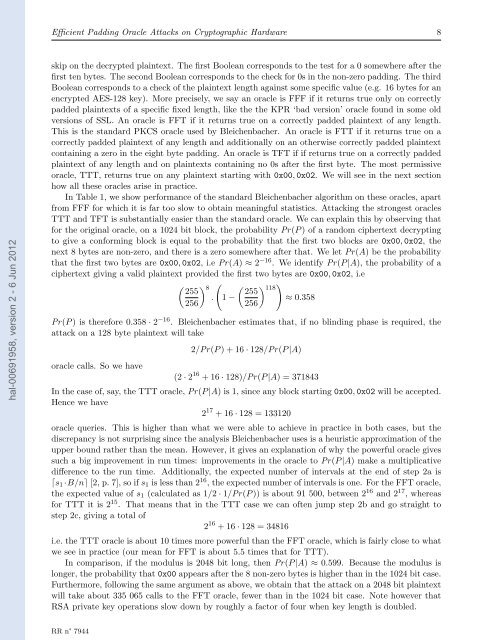RR-7944
RR-7944
RR-7944
Create successful ePaper yourself
Turn your PDF publications into a flip-book with our unique Google optimized e-Paper software.
hal-00691958, version 2 - 6 Jun 2012<br />
Efficient Padding Oracle Attacks on Cryptographic Hardware 8<br />
skip on the decrypted plaintext. The first Boolean corresponds to the test for a 0 somewhere after the<br />
first ten bytes. The second Boolean corresponds to the check for 0s in the non-zero padding. The third<br />
Boolean corresponds to a check of the plaintext length against some specific value (e.g. 16 bytes for an<br />
encrypted AES-128 key). More precisely, we say an oracle is FFF if it returns true only on correctly<br />
padded plaintexts of a specific fixed length, like the the KPR ‘bad version’ oracle found in some old<br />
versions of SSL. An oracle is FFT if it returns true on a correctly padded plaintext of any length.<br />
This is the standard PKCS oracle used by Bleichenbacher. An oracle is FTT if it returns true on a<br />
correctly padded plaintext of any length and additionally on an otherwise correctly padded plaintext<br />
containing a zero in the eight byte padding. An oracle is TFT if if returns true on a correctly padded<br />
plaintext of any length and on plaintexts containing no 0s after the first byte. The most permissive<br />
oracle, TTT, returns true on any plaintext starting with 0x00, 0x02. We will see in the next section<br />
how all these oracles arise in practice.<br />
In Table 1, we show performance of the standard Bleichenbacher algorithm on these oracles, apart<br />
from FFF for which it is far too slow to obtain meaningful statistics. Attacking the strongest oracles<br />
TTT and TFT is substantially easier than the standard oracle. We can explain this by observing that<br />
for the original oracle, on a 1024 bit block, the probability Pr(P ) of a random ciphertext decrypting<br />
to give a conforming block is equal to the probability that the first two blocks are 0x00, 0x02, the<br />
next 8 bytes are non-zero, and there is a zero somewhere after that. We let Pr(A) be the probability<br />
that the first two bytes are 0x00, 0x02, i.e Pr(A) ≈ 2−16 . We identify Pr(P |A), the probability of a<br />
ciphertext giving a valid plaintext provided the first two bytes are 0x00, 0x02, i.e<br />
� � �<br />
8 � � �<br />
118<br />
255<br />
255<br />
. 1 −<br />
≈ 0.358<br />
256<br />
256<br />
Pr(P ) is therefore 0.358 · 2 −16 . Bleichenbacher estimates that, if no blinding phase is required, the<br />
attack on a 128 byte plaintext will take<br />
oracle calls. So we have<br />
2/Pr(P ) + 16 · 128/Pr(P |A)<br />
(2 · 2 16 + 16 · 128)/Pr(P |A) = 371843<br />
In the case of, say, the TTT oracle, Pr(P |A) is 1, since any block starting 0x00, 0x02 will be accepted.<br />
Hence we have<br />
2 17 + 16 · 128 = 133120<br />
oracle queries. This is higher than what we were able to achieve in practice in both cases, but the<br />
discrepancy is not surprising since the analysis Bleichenbacher uses is a heuristic approximation of the<br />
upper bound rather than the mean. However, it gives an explanation of why the powerful oracle gives<br />
such a big improvement in run times: improvements in the oracle to Pr(P |A) make a multiplicative<br />
difference to the run time. Additionally, the expected number of intervals at the end of step 2a is<br />
⌈s1 ·B/n⌉ [2, p. 7], so if s1 is less than 2 16 , the expected number of intervals is one. For the FFT oracle,<br />
the expected value of s1 (calculated as 1/2 · 1/Pr(P )) is about 91 500, between 2 16 and 2 17 , whereas<br />
for TTT it is 2 15 . That means that in the TTT case we can often jump step 2b and go straight to<br />
step 2c, giving a total of<br />
2 16 + 16 · 128 = 34816<br />
i.e. the TTT oracle is about 10 times more powerful than the FFT oracle, which is fairly close to what<br />
we see in practice (our mean for FFT is about 5.5 times that for TTT).<br />
In comparison, if the modulus is 2048 bit long, then Pr(P |A) ≈ 0.599. Because the modulus is<br />
longer, the probability that 0x00 appears after the 8 non-zero bytes is higher than in the 1024 bit case.<br />
Furthermore, following the same argument as above, we obtain that the attack on a 2048 bit plaintext<br />
will take about 335 065 calls to the FFT oracle, fewer than in the 1024 bit case. Note however that<br />
RSA private key operations slow down by roughly a factor of four when key length is doubled.<br />
<strong>RR</strong> n° <strong>7944</strong>


